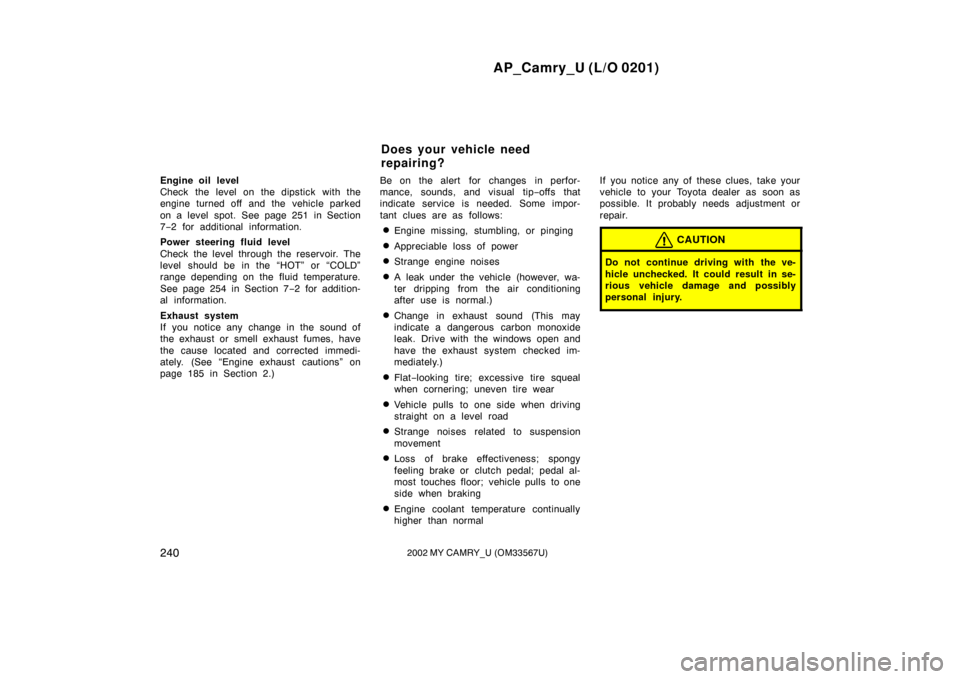Page 243 of 293

AP_Camry_U (L/O 0201)
2392002 MY CAMRY_U (OM33567U)
Lights
Make sure the headlights, stop lights, tail
lights, turn signal lights, and other lights
are all working. Check headlight aim.
Service reminder indicators and warning
buzzers
Check that all service reminder indicators
and warning buzzers function properly.
Steering wheel
Be alert for changes in steering condition,
such as hard steering or strange noise.
Seats
Check that all front seat controls such as
seat adjusters, seatback recliner, etc. op-
erate smoothly and that all latches lock
securely in any position. Check that the
head restraints move up and down
smoothly and that the locks hold securely
in any latched position. For folding−down
rear seatbacks, check that the latches
lock securely.
Seat belts
Check that the seat belt system such as
buckles, retractors and anchors operate
properly and smoothly. Make sure that the
belt webbings not cut, frayed, worn or
damaged. Accelerator pedal
Check the pedal for smooth operation and
uneven pedal effort or catching.
Clutch pedal
Check the pedal for smooth operation.
Brake pedal
Check the pedal for smooth operation and
that the pedal has the proper clearance.
Check the brake booster function.
Brakes
At a safe place, check that the brakes do
not pull to one side when applied.
Parking brake
Check that the lever has the proper travel
and that, on a safe incline, your vehicle
is held securely with only the parking
brake applied.
Automatic transmission “Park” mecha-
nism
Check the lock release button of the se-
lector lever for proper and smooth opera-
tion. On a safe incline, check that your
vehicle is held securely with the selector
lever in “P” position and all brakes re-
leased.
IN THE ENGINE COMPARTMENT
Items listed below should be checked
from time to time, e.g. each time when
refueling.
Washer fluid
Make sure there is sufficient fluid in the
tank. See page 266 in Section 7
−3 for
additional information.
Engine coolant level
Make sure the coolant level is between
the “F” and “L” lines on the see −through
reservoir when the engine is cold. See
page 252 in Section 7 −2 for additional
information.
Radiator, condenser and hoses
Check that the front of the radiator and
condenser are clean and not blocked with
leaves, dirt, or insects. See page 253 in
Section 7 −2 for additional information.
Battery condition
Check the battery condition by the indica-
tor color. See page 263 in Section 7 −3 for
additional information.
Brake fluid level
Make sure the brake fluid level is correct.
See page 254 in Section 7 −2 for addition-
al information.
Page 244 of 293

AP_Camry_U (L/O 0201)
2402002 MY CAMRY_U (OM33567U)
Engine oil level
Check the level on the dipstick with the
engine turned off and the vehicle parked
on a level spot. See page 251 in Section
7−2 for additional information.
Power steering fluid level
Check the level through the reservoir. The
level should be in the “HOT” or “COLD”
range depending on the fluid temperature.
See page 254 in Section 7 −2 for addition-
al information.
Exhaust system
If you notice any change in the sound of
the exhaust or smell exhaust fumes, have
the cause located and corrected immedi-
ately. (See “Engine exhaust cautions” on
page 185 in Section 2.) Be on the alert for changes in perfor-
mance, sounds, and visual tip
−offs that
indicate service is needed. Some impor-
tant clues are as follows:
�Engine missing, stumbling, or pinging
�Appreciable loss of power
�Strange engine noises
�A leak under the vehicle (however, wa-
ter dripping from the air conditioning
after use is normal.)
�Change in exhaust sound (This may
indicate a dangerous carbon monoxide
leak. Drive with the windows open and
have the exhaust system checked im-
mediately.)
�Flat −looking tire; excessive tire squeal
when cornering; uneven tire wear
�Vehicle pulls to one side when driving
straight on a level road
�Strange noises related to suspension
movement
�Loss of brake effectiveness; spongy
feeling brake or clutch pedal; pedal al-
most touches floor; vehicle pulls to one
side when braking
�Engine coolant temperature continually
higher than normal If you notice any of these clues, take your
vehicle to your Toyota dealer as soon as
possible. It probably needs adjustment or
repair.
CAUTION
Do not continue driving with the ve-
hicle unchecked. It could result in se-
rious vehicle damage and possibly
personal injury.
Does your vehicle need
repairing?
Page 279 of 293

AP_Camry_U (L/O 0201)
2762002 MY CAMRY_U (OM33567U)
COOLING SYSTEM
Total capacity, L (qt., Imp. qt.):2AZ− FE engine 6.2 (6.6, 5.4)
1MZ −FE engine 9.2 (9.8, 8.1)
Coolant type:
“TOYOTA Long Life Coolant” or equiva-
lent
With ethylene− glycol type coolant for a
proper corrosion protection of aluminum
components
Do not use alcohol type antifreeze or
plain water alone.
BATTERY
Open voltage
∗ at 20 �C (68 �F):
12.6—12.8V Fully charged
12.2—12.4V Half charged
11.8—12.0V Discharged
∗: Voltage that is checked 20 minutes af-
ter the key is removed with all the lights
turned off
Charging rates: 5 A max.
Note: If replacement is necessary, make
sure to do so with a battery that meets
the same standard as the original. CLUTCH
Pedal free play, mm (in.):
5—15 (0.2—0.6)
Fluid type: SAE J1703 or FMVSS No.116 DOT 3
MANUAL TRANSAXLE
Oil capacity, L (qt., Imp. qt.): 2.5 (2.6, 2.2)
Oil type: Gear oil API GL −4 or GL −5
Recommended oil viscosity: SAE 75W −90 AUTOMATIC TRANSAXLE
Fluid capacity (drain and refill), L (qt.,
Imp. qt.):
2AZ− FE engine 3.9 (4.1, 3.4)
1MZ −FE engine 3.5 (3.7, 3.1)
Fluid type: Automatic transmission fluid Type T −IV
Change automatic transmission fluid only
as necessary.
Generally, it is necessary to change
automatic transmission fluid only if your
vehicle is driven under one of the Special
Operating Conditions listed in your
“Scheduled Maintenance Guide” or
“Owner ’s Manual Supplement”. When
changing the automatic transmission fluid,
use only Toyota Genuine ATF Type T −IV
(ATF JWS3309 or NWS6500) to aid in
assuring optimum transaxle performance.
Notice: Using automatic transmission
fluid other than Toyota Genuine ATF
Type T�IV may cause deterioration in
shift quality, locking up of your trans-
mission accompanied by vibration, and
ultimately damage the automatic trans-
mission of your vehicle.